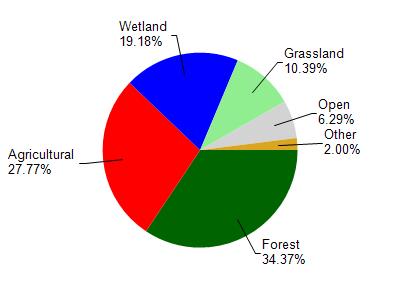Waushara, Winnebago
No
No
Yes
Fish and Aquatic Life
Overview
Pumpkinseed Creek originates in wetland areas and ditches south of Lake Poygan and eventually empties into Lake Poygan. The lower three miles are influenced by Lake Poygan's water quality and levels. The upper reaches receive runoff from agricultural fields and drainage ditches
From: Bougie, Cheryl A., Kosmond, Lisa D, and Watermolen, Dreux J. 1996. Wolf River Basin Water Quality Management Plan. Wisconsin Department of Natural Resources, Madison, WI.
Date 1996
Author Cheryl Bougie
Historical Description
Pumpkinseed Creek, T19N, R14E, Section 30 (6), Area = 25.7 acres, Length = 12.5 miles, Gradient = 11.0 feet/mile.
Pumpkinseed Creek, like so many other streams in Winnebago County, contains water but has no
measurable flow at four water stages. The water is hard and medium brown in color. The lower
mile of stream flows through Poygan Marsh and contains a fishery consisting of largemouth bass,
northern pike bluegill, pumpkinseed, bowfin, and crappie, along with other less common species.
The remainder of the stream is ditched and contains a fishery consisting mainly of forage species.
Waterfowl and aquatic furbearers are common. Three quarters of the stream flows through marsh with the remainder being cultivated or pastured. Aquatic vegetation is dense. A few artesian wells flow into the stream. About 1.2 miles of stream lie within state owned public hunting grounds. Additional public access is available from one county
road and one town road.
From: 1975. Surface Water Resources of Winnebago County: Lake and Stream Classification Project.
Wisconsin Department of Natural Resources, Madison, WI.
Date 1975
Author Surface Water Inventory Of Wisconsin
Impaired Waters
Pumpkinseed Creek (WBIC 243300) was assessed during the 2016 listing cycle; total phosphorus sample data exceed 2016 WisCALM listing criteria for the Fish and Aquatic Life use and biological impairment was observed (i.e. at least one macroinvertebrate or fish Index of Biotic Integrity (IBI) scored in the poor condition category).
Date 2015
Author Aaron Larson
Condition
Wisconsin has over 84,000 miles of streams, 15,000 lakes and milllions of acres of wetlands. Assessing the condition of this vast amount of water is challenging. The state's water monitoring program uses a media-based, cross-program approach to analyze water condition. An updated monitoring strategy (2015-2020) is now available. Compliance with Clean Water Act fishable, swimmable standards are located in the Executive Summary of Water Condition in 2018. See also the 'monitoring and projects' tab.
Reports
Recommendations
Restore Wetlands
Restore Wetlands
Navigability Determination
S1/2 NE 1/4 SE1/4 S9 T18N R14E; Pumpkinseed Creek; Determination extended to receiving water
Management Goals
Wisconsin's Water Quality Standards provide qualitative and quantitative goals for waters that are protective of Fishable, Swimmable conditions [Learn more]. Waters that do not meet water quality standards are considered impaired and restoration actions are planned and carried out until the water is once again fishable and swimmable
Management goals can include creation or implementation of a Total Maximum Daily Load analysis, a Nine Key Element Plan, or other restoration work, education and outreach and more. If specific recommendations exist for this water, they will be displayed below online.
Monitoring
Monitoring the condition of a river, stream, or lake includes gathering physical, chemical, biological, and habitat data. Comprehensive studies often gather all these parameters in great detail, while lighter assessment events will involve sampling physical, chemical and biological data such as macroinvertebrates. Aquatic macroinvertebrates and fish communities integrate watershed or catchment condition, providing great insight into overall ecosystem health. Chemical and habitat parameters tell researchers more about human induced problems including contaminated runoff, point source dischargers, or habitat issues that foster or limit the potential of aquatic communities to thrive in a given area. Wisconsin's Water Monitoring Strategy was recenty updated.
Grants and Management Projects
Monitoring Projects
| WBIC | Official Waterbody Name | Station ID | Station Name | Earliest Fieldwork Date | Latest Fieldwork Date | View Station | View Data |
|---|
| 243300 | Pumpkinseed Creek | 10036293 | Pumpkinseed Creek - Area of Open Water | | | Map | Data |
| 243300 | Pumpkinseed Creek | 10048589 | Pumpkinseed Creek | | | Map | Data |
| 243300 | Pumpkinseed Creek | 713313 | Pumpkinseed Creek - Near Winneconne WI | 6/19/2001 | 10/14/2025 | Map | Data |
| 243300 | Pumpkinseed Creek | 10036135 | Pumpkinseed Creek - Area of Open Water | | | Map | Data |
|

Watershed Characteristics
Pumpkinseed Creek is located in the Pine and Willow Rivers watershed which is 302.08 mi². Land use in the watershed is primarily forest (34.40%), agricultural (27.80%) and a mix of wetland (19.20%) and other uses (18.70%). This watershed has 377.48 stream miles, 11,273.01 lake acres and 33,136.61 wetland acres.
Nonpoint Source Characteristics
This watershed is ranked High for runoff impacts on streams, Not Ranked for runoff impacts on lakes and High for runoff impacts on groundwater and therefore has an overall rank of High. This value can be used in ranking the watershed or individual waterbodies for grant funding under state and county programs.However, all waters are affected by diffuse pollutant sources regardless of initial water quality. Applications for specific runoff projects under state or county grant programs may be pursued. For more information, go to surface water program grants.